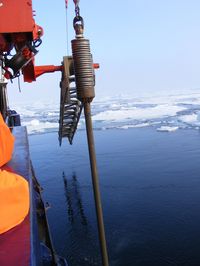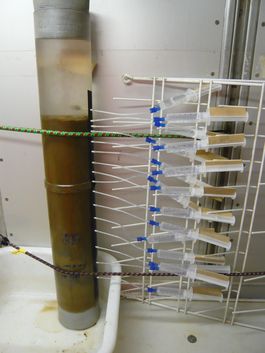Contact


Arctic Ocean
The Arctic Ocean and its sedimentary record
The Arctic, despite being one of the coldest regions on Earth, is currently a hot topic.
On one hand, it is a region where the phenomenon of „global warming“ is more evident than anywhere else. The disappearence of summer sea ice, the melting of the Greenland ice sheet, the fate of the ice- and cold-adapted ecosystems are subjects of vivid debates - not only in science, but also in politics.
On the other hand, the Arctic region gets more and more into the focus of economic interest, be it transportation and logistics, or exploration for oil, gas and ore deposits. The melting of the ice on sea and land uncovers seaways like the Northwest Passage, offering a shortcut for trade ships between Europe and Asia, and opens new opportunities for exploitation of metal and hydrocarbon reservoirs so far inaccessible. All in all, we are facing fundamental environmental changes around the North Pole.
However, one fundamental question arises: Are these climatic changes really so unique, or have similar changes occurred before? Has an ice-covered Arctic Ocean rather been an exception than the rule during Earth history? Answers to these and other questions can be deciphered from the sediments deposited at the bottom of the Arctic Ocean. We try to extract relevant information from these environmental archives by using inorganic geochemical proxies.
Research activities:
Inorganic- and organic-geochemical proxies for ice-rafting, river input, and early diagenesis in Quaternary Arctic Ocean sediments (DFG, SPP 527 IODP/OPD)
The focus lies on a high-resolution inorganic-geochemical study of central Arctic Ocean sediments and pore waters, spanning the Holocene to the Eemian Interglacial. Following a geochemical approach, we aim to investigate the spatial variability of sediment composition based on bulk sediment major and minor element patterns and on Fe and Mn speciation. The topical focus lies on the reconstruction of depositional processes (e.g. hemipelagic versus sea ice and iceberg sedimentation), changes in river input, the provenance of ice-transported material, early diagenetic processes, the climate-controlled variability of these parameters through the last glacial-interglacial cycle and a detailed investigation of the genesis and chemical expression of wide-spread dark brown Mn-rich sediment layers. This spatially extended study will also serve as preliminary work for the planning of future drilling projects in the Arctic Ocean.
• Meinhardt, A.-K., März, C., Stein, R., Brumsack, H.-J., 2014. Regional variations in sediment geochemistry on a transect across the Mendeleev Ridge (Arctic Ocean). Chemical Geology 369, 1-11.
• März, C., Stratmann, A., Matthiessen, J., Meinhardt, A.-K., Eckert, S., Schnetger, B., Vogt, C., Brumsack, H.-J., 2011. Manganese-rich brown layers in Arctic Ocean sediments: Composition, formation mechanism, and diagenetic overprint. Geochim. Cosmochim. Acta 75, 7668-7687.
Another focus is the Pliocene to Pleistocene history of the Bering Sea, which is situated between Siberia and Alaska (IODP Expedition 323). We are interested in reconstructing a) the paleoproductivity and nutrient inventory of the basin, which is currently amongst the most productive ocean regions worldwide; b) the stratification and redox history of the water column and its relation to the North Pacific; and c) the connection between the Arctic and Pacific Oceans via the shallow Bering Strait, which is highly sensitive to sea level fluctuations.
- März, C., Schnetger, B., Brumsack, H.-J. (2013) Nutrient leakage from the North Pacific to the Bering Sea (IODP site U1341) following the onset of Northern Hemispheric Glaciation? Paleoceanography, 28(1), 68 – 78.
Former research was related to the long-term history of the Arctic Ocean, from the Late Cretaceous (the age of the dinosaurs) until today (Expedition 302 of the Integrated Ocean Drilling Program (IODP), the so-called Arctic Coring Expedition (ACEX)).
- März, C., Schnetger, B. and Brumsack, H.-J. (2010) Paleoenvironmental implications of Cenozoic sediments from the central Arctic Ocean (IODP Expedition 302) using inorganic geochemistry. Paleoceanography, 25, PA3206

![[Translate to English:]](/f/5/_processed_/3/2/csm_ICBM-Logo-transparent-_91fe1c6774.png)